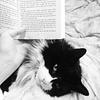Take a photo of a barcode or cover
18 reviews for:
Stopping the Noise in Your Head: The New Way to Overcome Anxiety and Worry
Reid Wilson
18 reviews for:
Stopping the Noise in Your Head: The New Way to Overcome Anxiety and Worry
Reid Wilson
Stopping the Noise in Your Head by R. Reid Wilson is a free NetGalley ebook that I read in the first week of May amongst a large group of people (which had once been a source of anxiety for me).
Wilson's narration changed instantly between the introduction and the main body of the book; from self-disclosure to being fully engaged with the reader in an easy-to-read, engaging, and harmlessly witty way. He teaches ways to reframe anxiety and to have it work with your other emotions/impulses in a positive, stabilizing way.
Wilson's narration changed instantly between the introduction and the main body of the book; from self-disclosure to being fully engaged with the reader in an easy-to-read, engaging, and harmlessly witty way. He teaches ways to reframe anxiety and to have it work with your other emotions/impulses in a positive, stabilizing way.
challenging
emotional
reflective
slow-paced
informative
inspiring
fast-paced
An interesting set of approaches to dealing with anxiety. One star deducted because I feel like the book could have been about 150 pages shorter.
The very best book I’ve read on treating and recovering from anxiety.
Interesting new way to level the playing field with anxiety and anxious thoughts
This is the whole book:
1) Move toward any task you predict will generate at least some uncertainty or distress regarding your worried theme.
2) When you notice feeling bothered by doubt or distress (whether before, during, or after that task):
A. Step back and acknowledge that it’s happening (“Ugh. This is hard”);
B. Welcome exactly what’s happening (“Yes, and this is what I’m looking for”); and
C. Subvocalize a message that helps you stay engaged in your chosen activity:
1) Encourage yourself (“I can do this”);
2) Instruct yourself (“Keep moving!”); or
3) Talk in a cunning way to Anxiety (“Give me more, please”).
3) Then turn your attention back to your chosen task, even while you still feel uncertain and uncomfortable.”
Add 10 to 20 pages that explain the above in more detail (mainly why the above is supposed to work). That’s it!
OK. Add another 10 pages for the two cases exemplifying these techniques.
If someone would’ve given me the above, it would’ve saved me going through 250 asking continuously “where is the meat???”
1) Move toward any task you predict will generate at least some uncertainty or distress regarding your worried theme.
2) When you notice feeling bothered by doubt or distress (whether before, during, or after that task):
A. Step back and acknowledge that it’s happening (“Ugh. This is hard”);
B. Welcome exactly what’s happening (“Yes, and this is what I’m looking for”); and
C. Subvocalize a message that helps you stay engaged in your chosen activity:
1) Encourage yourself (“I can do this”);
2) Instruct yourself (“Keep moving!”); or
3) Talk in a cunning way to Anxiety (“Give me more, please”).
3) Then turn your attention back to your chosen task, even while you still feel uncertain and uncomfortable.”
Add 10 to 20 pages that explain the above in more detail (mainly why the above is supposed to work). That’s it!
OK. Add another 10 pages for the two cases exemplifying these techniques.
If someone would’ve given me the above, it would’ve saved me going through 250 asking continuously “where is the meat???”
informative
ARC received from: Netgalley
One-Sentence Summary: How to fight anxiety
Review: Anxiety is so big a part of my life, even the thought of reading a book about anxiety makes me anxious but I am very glad that I got given an ARC of this and had the chance to read it.
Wilson's writing style if very conversational and therefore he made a book about a tricky subject very easy to read. He never lectures and seems to really understand what anxious people are going through, even though it all seems to irrational to non-anxious people.
The most helpful and interesting sections of the book to me are (in no particular order):
1. When Wilson goes into the science of what happens in your body when you feel anxious or panic (don't panic, he writes about it in a very easy to digest way).
2. How easy it is to rely on your "crutches" - this section really resonated with me because he talked about how a crutch would be making sure you take a seat at the end of the row, near an easy escape when you go to the theatre as you're worried you'll have a panic attack and need to escape in a hurry. Yes, I am guilty of this.
3. The difference between Signal and Noise and how most worries are Noise and you just need to keep telling yourself that.
4. Welcome the awful feelings of anxiety and step INTO, not away of problem situations, and the paradox of trying to "enjoy" all anxious feelings.
5. The "Act as though" principle. Walking into a room full of people who you don't know? Act As Though you are confident and not nervous (even if you really are!). In other words: FAKE IT TIL YOU MAKE IT!
6. And finally, Warning: What I’m about to say might just blow your mind. This right here might disrupt the whole worry system you’ve sculpted and perfected over the years. Ready? Brace yourself. Here it comes: What you often worry about isn’t worth your attention.
As to whether any of the techniques taught in this book actually work out for me, we'll just have to wait and see but I think I'll definitely be coming back to this book again and again to absorb Wilson's wise words.
One-Sentence Summary: How to fight anxiety
Review: Anxiety is so big a part of my life, even the thought of reading a book about anxiety makes me anxious but I am very glad that I got given an ARC of this and had the chance to read it.
Wilson's writing style if very conversational and therefore he made a book about a tricky subject very easy to read. He never lectures and seems to really understand what anxious people are going through, even though it all seems to irrational to non-anxious people.
The most helpful and interesting sections of the book to me are (in no particular order):
1. When Wilson goes into the science of what happens in your body when you feel anxious or panic (don't panic, he writes about it in a very easy to digest way).
2. How easy it is to rely on your "crutches" - this section really resonated with me because he talked about how a crutch would be making sure you take a seat at the end of the row, near an easy escape when you go to the theatre as you're worried you'll have a panic attack and need to escape in a hurry. Yes, I am guilty of this.
3. The difference between Signal and Noise and how most worries are Noise and you just need to keep telling yourself that.
4. Welcome the awful feelings of anxiety and step INTO, not away of problem situations, and the paradox of trying to "enjoy" all anxious feelings.
5. The "Act as though" principle. Walking into a room full of people who you don't know? Act As Though you are confident and not nervous (even if you really are!). In other words: FAKE IT TIL YOU MAKE IT!
6. And finally, Warning: What I’m about to say might just blow your mind. This right here might disrupt the whole worry system you’ve sculpted and perfected over the years. Ready? Brace yourself. Here it comes: What you often worry about isn’t worth your attention.
As to whether any of the techniques taught in this book actually work out for me, we'll just have to wait and see but I think I'll definitely be coming back to this book again and again to absorb Wilson's wise words.
Easy to read book that helps you stop unneccessary anxiety and worrying . If you suffer from over anxiety, stress, OCD, give this book a read.
challenging
funny
informative
inspiring
medium-paced





